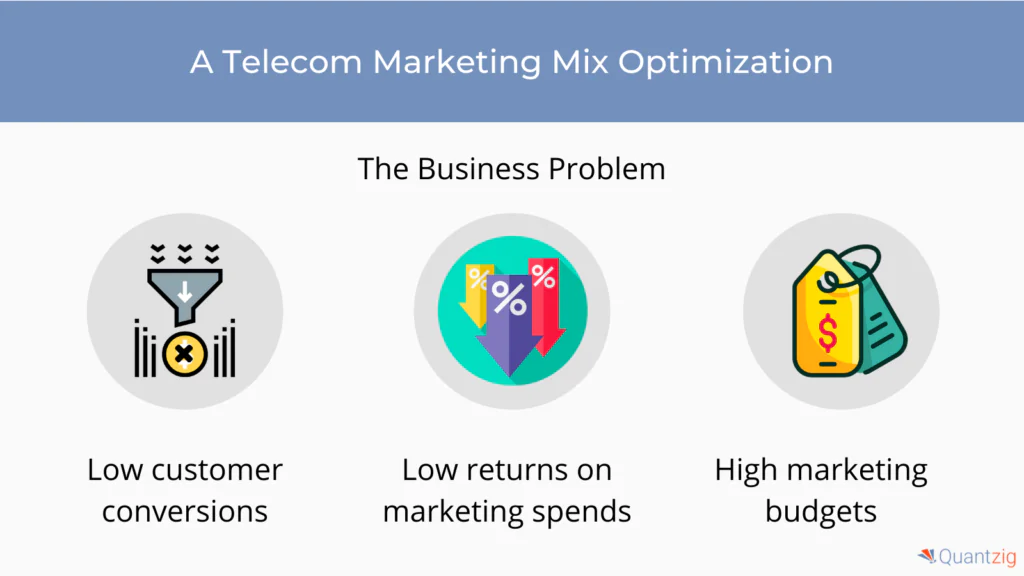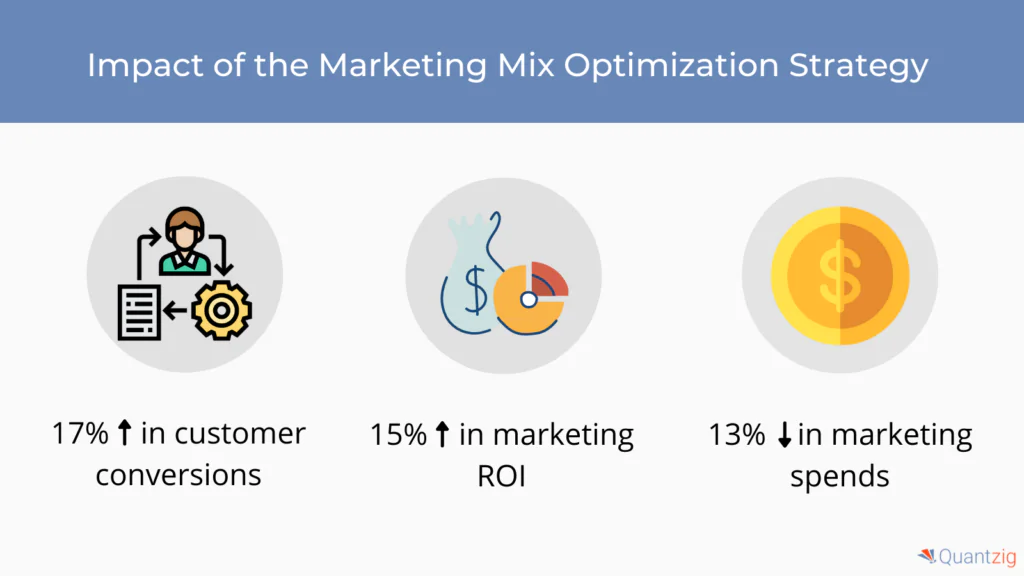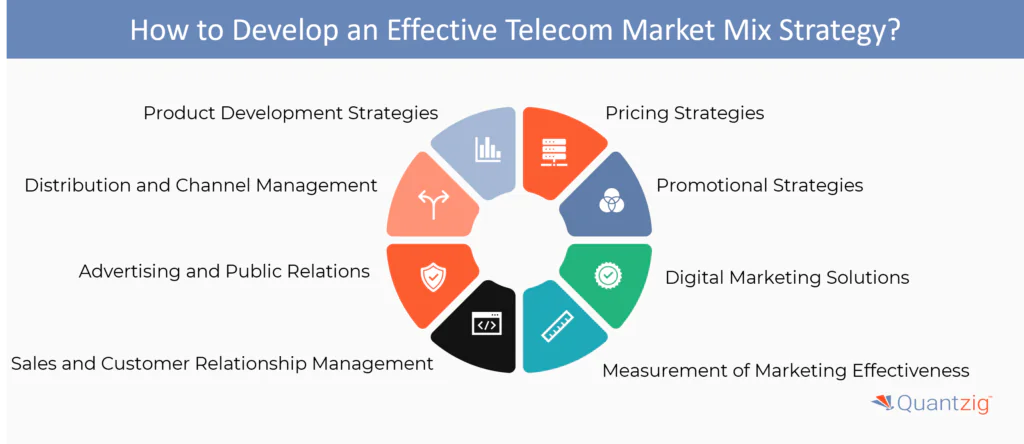Written By: Sudeshna Ghosh
Table of Contents
Introduction to Telecom Market Mix
Sustainable growth and a competitive edge demand precise optimization of the marketing mix solutions within the telecom industry. This optimization is crucial as it allows telecom companies to strategically position their offerings, distinguish themselves from rivals, attract and retain customers, and ultimately bolster revenue and profitability.
Quantzig’s comprehensive marketing mix optimization solution stands at the forefront, leveraging advanced analytics and cutting-edge methodologies to harness the power of data-driven insights. This strategic approach enables telecom companies to not only enhance their market presence and properly target market, but also cultivate enduring customer relationships, thereby fostering sustainable growth and maintaining a competitive edge in the ever-evolving telecom landscape. Let’s dive deeper into the article.
Request a demo to experience the meaningful insights we derive from data through our marketing mix analytics tools and platform capabilities. Schedule a demo today!
Request a Free DemoQuantzig’s Expertise in Telecom Market Mix Solution for a Global Telecommunication Service Provider
| Category | Details |
|---|---|
| Client Details | The client is a renowned telecom services provider with branches spread across the Asia-pacific region. |
| Challenges Faced by The Client | To deal with the issue of increasing market competition and rising budget concerns, the telecom marketing services provider wanted to understand the relationship between marketing spending and business performance, identify the potential sales drivers, and estimate the ROI on their marketing investments. |
| Solutions Offered by Quantzig | Quantzig developed marketing mix optimization solution to measure the impact of marketing activities on sales revenues. The implementation of AI technologies within the marketing plan facilitated real-time insights into the impact of marketing activities on sales performance. |
| Impact Delivered | 13% decrease in marketing spending 15% increase in MROI and branding 17% increase in customer conversions |
About the Client
The client is a renowned telecom services provider with branches spread across the Asia-pacific region.
Challenges Faced by the Client
The Asia-pacific region is anticipated to be one of the fastest-growing markets for telecom services across the globe. The client wanted to measure the impact of advertising, packaging, distribution channels, and media expenditure on the sales revenue. Their primary aim was to refine the existing telecom marketing models and marketing strategies for the telecommunication industry to improve overall telecom services market share. To deal with the issue of increasing market competition and rising budget concerns, the telecom marketing services provider wanted to understand the relationship between marketing spending and business performance, identify the potential sales drivers, and estimate the ROI on their marketing investments.
Telecom Market Mix Solutions Offered by Quantzig
- With the help of Quantzig’s marketing mix optimization solution, the marketing mix solutions implemented for the global telecommunication service provider successfully addressed their business challenge of measuring the impact of marketing activities on sales revenues. By incorporating advanced analytics and predictive insights, the solution enabled the client to gain accurate insights and results into their marketing investments and provided a more precise picture of their return on investment (ROI).
- Furthermore, the solution and the marketing plan offered strategic insights and results on how to improve customer retention capabilities, which is crucial in the highly competitive telecom services sector. By analyzing marketing models and strategies, the client was able to differentiate their products effectively and maximize their market share.
- The implementation of AI technologies within the marketing plan facilitated real-time insights into the impact of marketing activities on sales performance. This allowed the client to make informed decisions on future spend to maximize returns. Additionally, the solution leveraged technological advancements such as IoT and VoIP to enhance marketing effectiveness and optimize the marketing mix.
Impact Analysis from Quantzig’s Telecom Market Mix Solution
The marketing mix optimization case study demonstrated the business impact of leveraging predictive insights in the telecom industry. By partnering with utility providers and telecom providers, the client was able to achieve significant improvements in their marketing strategies and drive growth in their business.
The impact of marketing optimization solution and the marketing plan for the target market:
- 13% decrease in marketing spending
- 15% increase in MROI and branding
- 17% increase in customer conversions
Experience the advantages firsthand by testing a customized complimentary pilot designed to address your specific requirements. Pilot studies are non-committal in nature.
Request a Free PilotOverview of Telecom Industry
The telecommunication services sector is essential for the economic growth of the world and is one of the key support services needed for the rapid modernization of various sectors of the economy. In regions such as the developing countries, the market for telecom services has recorded exponential growth over the past few years – facilitated by the implementation of favorable policies and regulatory reforms by regional governments. Though the market for telecom services is expected to witness incremental growth some factors may influence the growth of the telecom services sector over the next few years. They include:
1. Growth in IoT:
As technology is a key enabler of competition, telecom services providers are facing pressures to stay relevant and offer VoIP and cloud-based communication services to stay relevant in the market. A recent study also highlights the fact that the number of connected devices is expected to manifold twice by the year 2020. This makes it mandatory for market players to implement systems that can leverage such technologies.
2. Diversification:
In this competitive environment, the telecom services providers are growing at a rapid pace and are expanding their reach to new markets. Therefore, it becomes essential for the service providers to develop new service lines to increase profitability and optimize their ROI.
3. Regulatory reforms:
The rising consumer demand and growing communication technology are forcing telecom services providers to reassess their business strategy and encourage investment in high-speed networks. Also, the development of 5G services is compelling telecom services providers to refine their existing digital infrastructure and meet the growing business and public demands.
To keep up with these rapid changes and develop effective marketing campaigns, leading telecom service providers are leveraging telecom marketing mix optimization. Marketing mix solutions are a statistical model that helps companies optimize the budget allotment for different marketing campaigns.
Telecom Market Mix Solutions: What is it?
Businesses use marketing mix solutions to target specific customer segments and create a competitive advantage in the market. By carefully managing the marketing mix, businesses can optimize their product offering, pricing strategy, advertising campaigns, and distribution channels. The goal of marketing mix solutions is to achieve a balanced approach that maximizes customer satisfaction and drives business growth.
According to Quantzig Experts, companies that implement effective marketing mix solutions experience an average increase in sales of 12.6%. Approximately 80% of businesses that invest in marketing mix solutions see a significant improvement in their brand reputation. Research shows that utilizing data-driven marketing mix solutions can result in a cost reduction of up to 15% for companies. A survey conducted among marketers revealed that 92% believe that incorporating digital marketing into their mix solutions has positively impacted their overall ROI. Companies that allocate at least 15% of their marketing budget towards innovative mix solutions are 20% more likely to outperform their competitors in terms of market share growth.
Why is Telecom Market Mix Important?
In the ever-evolving landscape of telecommunications, staying ahead requires more than just cutting-edge technology—it demands a strategic and refined approach to marketing. The pivotal key to success lies in the adept utilization of the marketing mix, a dynamic amalgamation of product, price, place, and promotion. For a telecom services provider, navigating this complex terrain necessitates not only staying attuned to consumer needs but also mastering the art of optimization. In this fiercely competitive arena, where customer expectations are constantly evolving, the role of marketing mix optimization cannot be overstated. It serves as the compass that guides telecom providers toward the fine-tuning of their marketing campaigns, ensuring not only relevance but a laser-focused resonance with target audiences.
This holistic approach is not merely a facet of modern business—it is the cornerstone that propels telecom providers into the forefront of the industry, enabling them to craft compelling narratives, set competitive pricing strategies, strategically position services, and amplify their promotional efforts. In essence, marketing mix optimization is the secret sauce that propels telecom providers beyond the ordinary, transforming their campaigns into strategic masterpieces that resonate, captivate, and ultimately dominate the market.
What are the Challenges in Implementing Telecom Marketing Mix Services?

Telecom marketing mix services involve strategically managing various elements of the marketing mix to effectively promote telecom products and services while maximizing return on investment. However, this process presents unique challenges within the telecom sector due to its dynamic nature and complex market dynamics.
Telecommunications companies operate in a highly competitive environment where multiple factors such as technological advancements, changing consumer preferences, regulatory requirements, and evolving market trends significantly impact their marketing strategies.
1. Quick Adaption of New Technology
One of the key challenges and branding is understanding and adapting to the rapidly evolving landscape of telecommunications technology. With the constant emergence of new technologies and processes, telecom companies must continuously innovate and integrate these advancements into their marketing mix to stay competitive.
2. Diverse Customer Base
Moreover, telecommunications marketing involves catering to a diverse customer base with varying needs and preferences. This requires telecom companies to carefully analyze customer data and behavior through data analytics and AI data analysis to tailor their marketing strategies accordingly. Understanding customer demographics, preferences, and usage patterns is crucial for effective targeting and personalization in marketing campaigns.
3. Ensure Consistent and High-Quality Customer Service
Customer experience and customer service also play a critical role in the components of the marketing mix solutions in the telecom industry. Providing superior customer service can serve as a unique selling proposition (USP) for telecom companies, helping them differentiate themselves from competitors. However, ensuring consistent and high-quality customer service across various touchpoints poses a significant challenge, especially in an industry with a vast customer base and diverse service offerings.
4. Analysis the Impact of Marketing Channels
Furthermore, telecom companies must leverage various marketing channels and processes such as social media, email marketing, and pay-per-click advertising to reach their target audience effectively. Managing social media reach and engagement, creating engaging marketing content, and optimizing pay-per-click campaigns are essential for maximizing the impact of marketing efforts in the telecom sector.
5. Understand Competitors’ Strategies
In addition to these challenges, telecom companies also need to keep a close eye on their competitors and market trends to stay ahead of the curve. Analyzing competitor strategies, monitoring market developments, and identifying new opportunities approaches allow them in staying relevant and competitive in the telecom market.
In summary, marketing mix optimization and processes in the telecommunications industry is a multifaceted challenge that requires telecom companies to navigate through various complexities, including technological advancements, customer dynamics, competition, and market trends, while effectively leveraging data analytics and customer-centric approaches to drive success in their marketing endeavors.
How to Develop an Effective Telecom Market Mix Strategy?
In today’s fiercely competitive business landscape, crafting and implementing effective marketing strategies is paramount for success. From product development to distribution, pricing to promotion, companies must navigate a complex array of factors to drive growth and maintain relevance in the market. Leveraging comprehensive market research, strategic analysis, and innovative techniques, organizations can optimize their efforts to reach their target audience, build brand equity, and drive sales. In this section, we explore key marketing strategies and solutions, highlighting the importance of strategic segmenting markets, positioning, and evaluation in achieving tangible business outcomes.
1. Product Development Strategies
Effective product development strategies are crucial for any company for sustaining growth and relevance. By leveraging comprehensive market research, companies can identify unmet needs and untapped opportunities, guiding the creation of innovative products that resonate with their target audience. Through rigorous analysis of customer feedback and competitive benchmarks, organizations can refine their product offerings to maintain a competitive advantage. Successful product development strategies are characterized by a deep understanding of customer needs, the packaging, a commitment to excellence, and a relentless pursuit of differentiation in the marketplace.
2. Pricing Strategies
Accurate pricing strategies are essential for optimizing profitability and maximizing market share. By carefully evaluating pricing elasticity and competitive dynamics, companies can determine optimal pricing levels that balance value perception with revenue objectives. Moreover, dynamic pricing mechanisms enable organizations to respond swiftly to changing market conditions and consumer preferences, ensuring sustained relevance and profitability.
3. Distribution and Channel Management
In the complex modern commerce landscape, effective distribution and channel management are paramount for reaching customers efficiently and maximizing market penetration. By leveraging data-driven insights and strategic partnerships, companies can optimize distribution networks to minimize costs and enhance service levels. Furthermore, a diversified channel strategy enables organizations to reach different customer segments through multiple touchpoints, increasing accessibility and convenience.
4. Promotional Strategies
Promotional strategies are essential for building brand awareness, convenience, quality, driving customer engagement, and ultimately, driving sales. By leveraging a mix of traditional and digital advertising channels, companies can reach their target audience with tailored messages that resonate and inspire action. Moreover, strategic segmentation and positioning ensure that promotional efforts are aligned with the needs and preferences of different customer segments, maximizing relevance and impact.
5. Advertising and Public Relations
In the modern marketing, advertising and public relations are essential for building brand equity, shaping perceptions, and driving consumer action. By leveraging a mix of traditional and digital media channels, companies can reach their target audience with compelling messages that resonate and inspire engagement. Moreover, strategic segmentation and positioning ensure that advertising and PR efforts are tailored to the needs and preferences of different customer segments, maximizing impact and relevance.
6. Digital Marketing Solutions
In the digital age, leveraging innovative digital marketing solutions is essential for reaching consumers where they are and driving engagement across multiple touchpoints. By harnessing the power of data-driven insights and advanced analytics, companies can personalize their marketing efforts, convenience and deliver relevant content to their target audience. Moreover, strategic segmentation and positioning enable organizations to tailor digital marketing campaigns to different customer segments, maximizing relevance and impact.
7. Sales and Customer Relationship Management
Sales and customer relationship management are essential for driving revenue growth and fostering long-term loyalty. By leveraging advanced analytics and predictive modeling techniques, companies can identify high-potential prospects and tailor their sales efforts to maximize conversion rates. Moreover, strategic segmentation and positioning enable organizations to personalize their sales approach to different customer segments, maximizing relevance and effectiveness.
8. Evaluation and Measurement of Marketing Effectiveness
In the data-driven modern marketing, rigorous evaluation and measurement of marketing strategy and marketing effectiveness are essential for optimizing ROI and for brands to drive continuous improvement. By leveraging advanced analytics and performance metrics, companies can track the impact of their marketing efforts across various channels and touchpoints. Moreover, strategic segmentation and positioning enable organizations to evaluate the effectiveness of different marketing initiatives among different customer segments, guiding resource allocation and strategic decision-making.
Developing an effective telecom market mix strategy involves leveraging key marketing theories and creating a robust communications mix. Integrate direct marketing, integrated multi-channel, and omni-channel campaigns to reach a broad audience while enhancing customer retention and brand loyalty. Utilize customer data for data-driven marketing, optimizing the promotional mix to reduce customer churn and improve click-through rates. Tailor loyalty programs specifically for the Telecoms industry to boost engagement. By focusing on these elements, Telcos can achieve a comprehensive and effective marketing mix that drives sustained growth and customer satisfaction.
Conclusion
In conclusion, the transformative power of marketing mix in telecom sector is nothing short of a game-changer in the highly competitive landscape. As we traverse the digital age, where consumer preferences are as dynamic as the technological advancements that define the industry, the ability to refine and adapt marketing campaigns becomes paramount.
The strategic orchestration of product, price, place, and promotion through optimization not only enhances market positioning but also cultivates a responsive and agile marketing approach. It is the cornerstone that empowers telecom providers to not merely respond to market changes but to proactively shape them. By leveraging the insights derived from optimization, marketers can tailor their strategies to meet the evolving demands of their audience, establishing a symbiotic relationship that transcends transactional exchanges.
Get started with your complimentary trial today and delve into our platform without any obligations. Explore our wide range of customized, consumption driven analytical solutions services built across the analytical maturity levels.
Start your Free Trial






